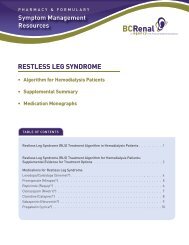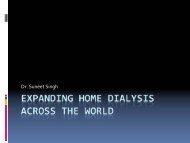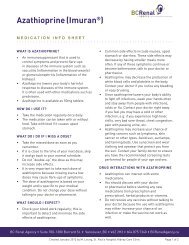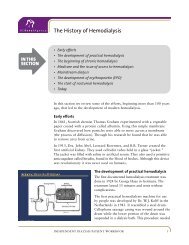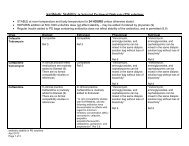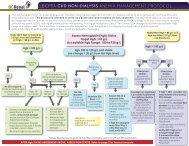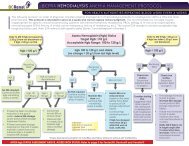CLINICAL PRACTICE DECISION SUPPORT TOOL - BC Renal Agency
CLINICAL PRACTICE DECISION SUPPORT TOOL - BC Renal Agency
CLINICAL PRACTICE DECISION SUPPORT TOOL - BC Renal Agency
You also want an ePaper? Increase the reach of your titles
YUMPU automatically turns print PDFs into web optimized ePapers that Google loves.
Calcium Additive Guideline for Patients Receiving<br />
Nightly Nocturnal Hemodialysis<br />
IAMHD Home<br />
Hemodialysis Clinical<br />
Practice Standards<br />
and Procedures<br />
Section: HHD Origin Date: February 2007<br />
Revised: June 2009<br />
PRINTED copies of Clinical Practice Standards and Procedures may not be the most recent version.<br />
The most current version is located on <strong>BC</strong>PRA Website (www.bcrenalagency.ca)<br />
1.0 <strong>PRACTICE</strong> STANDARD<br />
To provide guidelines to the Healthcare Providers as to when and how to supplement the<br />
nightly nocturnal hemodialysis prescription with additional Calcium.<br />
The Healthcare Providers will review patient’s blood work and under the direction of the<br />
Nephrologist will determine the dose of Calcium to be added to the patient’s Dialysate.<br />
The Registered Nurse Educators will have the necessary knowledge and skills to perform<br />
and teach the protocol competently.<br />
The patient will demonstrate an understanding of the procedure, and have documentation<br />
included on the chronic dialysis clinic chart confirming successful certification in this<br />
procedure.<br />
2.0 DEFINITIONS AND ABBREVIATIONS<br />
Nightly Nocturnal Hemodialysis is defined as five (5) or more treatments per week, of a<br />
duration of at least 6 hours per treatment (totalling a minimum of 30 hours per week of<br />
dialysis)<br />
Calcium – Ca; [Ca ++ ] ionized calcium formula<br />
Calcium Chloride – CaCl 2<br />
Phosphate – PO 4<br />
Parathyroid – PTH<br />
3.0 EQUIPMENT<br />
<br />
<br />
<br />
CaCl 2 powder as ordered by Nephrologist<br />
o 7.45 g/L vial equivalent to an addition of 0.25 mmol/L per 4.5L jug of dialysate<br />
o 14.8 g/L vial equivalent to an addition of 0.5 mmol/L per 4.5L jug of dialysate<br />
4.5L Acid Dialysate jug as ordered by Nephrologist<br />
Calibrated measuring cup
Calcium Additive Guideline for Patients Receiving<br />
Nightly Nocturnal Hemodialysis<br />
4.0 PROCEDURE RATIONALE<br />
1. Consider low dose vitamin D analogue to<br />
promote calcium (and phosphate)<br />
absorption from GI tract, in consultation<br />
with the Nephrologist and the dietitian.<br />
2. Consider discharging Nightly Nocturnal<br />
Hemodialysis patients on a 1.5 mmol/L<br />
calcium baths as the ‘baseline’ calcium<br />
bath or as appropriate for that patient.<br />
3. Laboratory testing should utilize total<br />
calcium levels.<br />
4. As a correction factor for determining total<br />
calcium, add 0.2 mmol/L to measured<br />
calcium for each 10 g/L drop in albumin<br />
below 40 g/L. No correction factor is<br />
required for albumins in excess of 40 g/L.<br />
5. Calcium, Phosphate, and Albumin levels<br />
should be drawn simultaneously.<br />
6. Liberalize dietary calcium intake (in<br />
consultation with a renal dietitian) when<br />
pre-dialysis calcium level (total) falls below<br />
2.3 mmol/L, or post-dialysis calcium levels<br />
fall below 2.5 mmol/L.<br />
7. Calcium supplementation should be<br />
considered to maintain the following<br />
parameters:<br />
a. Pre-dialysis calcium level should be in<br />
the upper limit of the normal range (i.e.<br />
total calcium level pre-dialysis of 2.3 –<br />
2.6 mmol/L)<br />
b. Post-dialysis calcium level should be<br />
in the mildly hypercalcemic range (i.e.<br />
total calcium level post-dialysis of 2.5<br />
– 2.8 mmol/L).<br />
8. If pre- and post-dialysis total calcium<br />
levels are below the ranges indicated in<br />
#7 above, commence calcium<br />
supplementation into the dialysate.<br />
Nightly Nocturnal hemodialysis provides an<br />
opportunity for the patient to improve their<br />
diet, reducing the need to alter the HD<br />
treatment.<br />
In Nightly Nocturnal hemodialysis, the<br />
efficiency of the dialysis should reduce the<br />
need to remove extra calcium from the<br />
patients’ blood and may require the addition of<br />
extra Ca to avoid negative calcium balance.<br />
Due to technical difficulties obtaining ionized<br />
calcium in a home hemodialysis patient.<br />
To obtain the equivalent to ionized calcium.<br />
We recognize that there are other formulae<br />
available to correct the calcium, but this<br />
formula is simple and relatively reliable.<br />
Programs may opt to use another formula,<br />
which is reasonable, provided all providers<br />
use the same formula consistently.<br />
To ensure validity of the calcium levels, the<br />
albumin level at the time the Ca is drawn is<br />
required.<br />
To reduce the amount of calcium needed to<br />
be added to the Dialysate. In extended<br />
dialysis the efficiency of the dialysis should<br />
reduce the need to remove extra calcium from<br />
the patients’ blood.<br />
Currently there are no published guidelines for<br />
calcium targets in the Nightly Nocturnal<br />
Hemodialysis patient. However, due to risk of<br />
negative calcium balance with ultrafiltrative<br />
losses with this modality result in an opinion<br />
based recommendation to increase calcium<br />
targets. This opinion has been reviewed by<br />
Nightly Nocturnal Hemodialysis programs in<br />
both Canada and the USA, and has been<br />
endorsed by most programs.<br />
Addition of Calcium into the dialysate is the<br />
preferred method to achieve calcium targets,<br />
as this ensures systemic absorption of<br />
calcium. Oral supplementation is<br />
unpredictable with respect to calcium<br />
absorption.<br />
Page 2 of 4
Calcium Additive Guideline for Patients Receiving<br />
Nightly Nocturnal Hemodialysis<br />
9. Recommended initial dose of CaCl 2<br />
additive is ½ of a 7.45 g/L vial calcium<br />
‘spike’ added to 4.5 L dialysate acid<br />
concentrate jug (to raise [Ca ++ ] by 0.125<br />
mmol/L).<br />
10. Repeat pre- and post-dialysis calcium<br />
levels 1 week following initiation of<br />
supplementation.<br />
11. If within target range, continue with same<br />
amount of additive to every dialysis<br />
treatment.<br />
12. If after supplementation as noted in item<br />
#9 the blood calcium level remains below<br />
target range, repeat steps 9–10, until<br />
within target range. Then proceed to #13<br />
below.<br />
13. When within target range, continue with<br />
same volume of CaCl 2 additive every<br />
dialysis treatment.<br />
13. Chronic monitoring of pre- and posthemodialysis<br />
calcium levels should be<br />
performed with monthly blood testing.<br />
To permit cautious achievement of the target<br />
calcium levels, as noted above.<br />
To assess levels and monitor for calcium<br />
levels outside of target range (above or below<br />
target limits).<br />
To maintain Ca levels within target range.<br />
To achieve target calcium levels.<br />
To maintain Ca levels within target range.<br />
To maintain Ca levels within target range.<br />
5.0 DOCUMENTATION CONSIDERATIONS<br />
1. Document ‘Certification of Competence’ for the patient in the permanent hemodialysis<br />
record.<br />
2. Document ‘Independent Hemodialysis Calcium Additive’ changes in the Doctor’s Orders<br />
sheet on the permanent hemodialysis record.<br />
3. Process as per other medication and dialysis prescription orders. Ensure the correct<br />
amount is recorded and updated on the patient Kardex, and in the Hemodialysis<br />
treatment field in PROMIS database.<br />
4. Document patient’s response to treatment, as reported by the patient.<br />
5. Document communications with Nephrologist.<br />
6. Notify Equipment vendor of Additives to concentrates, to allow for adjustment of<br />
machine conductivity limits, if needed.<br />
6.0 SPECIAL CONSIDERATIONS<br />
In the treatment of patients with End-Stage Kidney Failure, on chronic hemodialysis,<br />
abnormalities in both calcium and phosphate metabolism are very common. Phosphate<br />
management is covered in a separate clinical guideline.<br />
In patients on dialysis, abnormalities of calcium levels can be either that the serum calcium<br />
level is too low (hypocalcemia), or too high (hypercalcemia). Calcium derangements are<br />
due to many factors, including alteration in vitamin metabolism (i.e. Vitamin D deficiency),<br />
alteration in hormonal functions (i.e. altered parathyroid hormone homeostasis), and<br />
Page 3 of 4
Calcium Additive Guideline for Patients Receiving<br />
Nightly Nocturnal Hemodialysis<br />
changes caused by medications (i.e. calcium-containing phosphate binders).<br />
With the increased dose of dialysis, particularly in patients receiving Nightly Nocturnal<br />
Hemodialysis, the spectrum of observed calcium abnormalities changes. This is because of<br />
changes in the dietary consumption, the dialysis prescription, in the medication<br />
requirements (i.e. elimination of phosphate binders), and normalization of the hormonal<br />
milieu (i.e. suppression of PTH). Additionally, the weekly volume of ultrafiltrate increases<br />
(assuming minimum UFR 0.3 L/hour x 8 hours x 5 times per week = 12 L ultrafiltration per<br />
week). Each litre of ultrafiltrate is a balanced fluid, and hence the clearance of calcium<br />
(assuming total serum calcium = 2.4 mmol/L) is 28.8 mmols. Failure to account for this will<br />
result in a negative calcium balance over time, and must be compensated for.<br />
Despite the higher calcium targets used for patients receiving Nightly Nocturnal<br />
Hemodialysis, the risk of extra-osseous calcification appears to be reduced, due to an<br />
overall improvement in the CaxP product (primarily because of an improvement in<br />
Phosphate levels). The risk of vascular calcification in Nightly Nocturnal Hemodialysis is<br />
not known at this time, and is the source of ongoing research.<br />
7.0 REFERENCES<br />
Daugirdas, J., Blake, P., & Ing, T., (Eds.). (2001). Handbook of Dialysis. Lippincott,<br />
Williams & Wilkins, NY.<br />
National Kidney foundation Dialysis Outcomes Initiative (KDOQI Guidelines).<br />
8.0 DEVELOPED BY<br />
Home Hemodialysis Educators<br />
<strong>Renal</strong> Educators<br />
9.0 REVIEWED BY<br />
Provincial Medical Director, Home Hemodialysis Program<br />
10.0 ENDORSED BY<br />
<strong>BC</strong>PRA Provincial Medical Advisory Counsel (June 2009)<br />
Provincial IAMHD Program Operations Group (Spring 2009)<br />
1 Disclaimer: The procedure steps may not epic actual sequence of events. Patient/Client/Resident specifics must be considered in<br />
applying Interior Health Clinical Practice Decision Support Tools.<br />
Page 4 of 4




